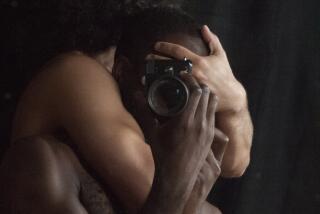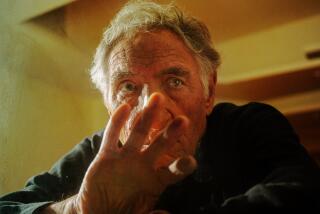Hand-Held Meter Can Balance the Light
- Share via
Q I recently attempted some indoor flash photography. However, I had a strong diffused light coming through the window. The added light gave me a difficult exposure problem, leaving my shots overexposed.
Are light quantities additive or was it the slow sync at 1/60 of a second that allowed the additional light to be a problem?
Also, I do a lot of outdoor model work and I recently noticed a cast difference reflected in my processed prints. These differences seemed to correspond with varying times of the day, which I now realize is the result of color temperature differences. I had flesh tones that were perfect at 2 p.m. but had a red cast one or two hours later. I did use fill-flash but it still didn’t give me the colors I wanted. I didn’t want to shoot at 11 or 12 because of the high contrast. What should I do?
Everett Gordon,
Westminster
A Anytime you have two different light sources when photographing your subject, it is important to have the correct balance between the two to get the proper exposure.
Most of today’s newer electronic cameras do a fairly good job of balancing a proper exposure between your two light sources. However, to get the best exposure in a situation where you have both flash and natural light, use a hand-held exposure meter. I use the Minolta Flash Meter IV, which takes flash readings accurate to 1/10 of an f-stop and ambient light readings, which sometimes fool the meter in a single-lens-reflex camera.
Another problem is with the shutter speed. Taking a picture at 1/60 when there are two light sources usually will lead to overexposure. Most of the time, a 1/60 shutter-speed flash-sync is too low to combine flash with bright outdoor sunlight. If you are planning to shoot a lot of high-quality outdoor strobe photography, purchasing a camera with a flash shutter sync of 1/250 is essential.
When shooting indoors, try moving the subject farther away from the window.
As for your color-balance problem on your prints, you were correct in assuming that the time of day was a factor. Late afternoon sunlight will definitely add an orange cast to your photos. Sometimes, this effect is desirable if you are seeking a warmer tone to your photos.
Using an 80C filter, which has a blue cast, can correct the problem. Also, you will need to compensate for the filter when figuring your exposure setting unless you’re metering through your lens. Remember, using filters is not an exact science. For the best results, bracket your exposures. And, for comparison, try shooting some of the photographs without a filter.
Another idea is to use sunlight as your backlight and your strobe as your main light. This may give you the truer color balance you are looking for. If price isn’t a factor and you want to get more technical, get a color meter.
Don’t discount the possibility that your color lab has incorrectly balanced the color in your photos. Quality can vary greatly from lab to lab, so find one that consistently gives you the quality you are looking for.
Q I’m interested in knowing about compact 35-mm cameras with two lenses
wide angle and telephoto. Are they a good idea and what kind of photographers would be interested in them?
Charles Daily,
Laguna Hills
A The new line of compact 35-mm cameras has had a major impact on the photo field. They also have spawned a new generation of one-hour photo developing shops, because taking pictures has become so easy.
These cameras are the ultimate in point-and-shoot photography. They afford consumers many conveniences that the higher-priced cameras do not. The built-in flash along with automatic winding and rewinding, automatic exposure and automatic focus have taken photography from a very difficult procedure to something almost anyone can do.
Most professional photographers, myself included, use one of these cameras for around-the-home family photography. It’s especially handy on holidays and if you plan to take a trip. The compactness of the camera makes it a pleasure to take, whereas carrying a bulky single-lens reflex with its variety of lenses can take the fun out of traveling.
The compact 35-mm camera that features a combination wide angle and telephoto lens is perfect for most photographers. Look for one that spans a range from 35 millimeters to at least 70 millimeters. You should plan to spend at least $200 for a camera with this feature.
Almost every camera manufacturer makes a camera of this type, so shop around before you buy.
The photography column, which runs each Saturday in Orange County Life, is designed to help both the serious amateur and weekend shooter. Questions and ideas are welcome and encouraged. Write Robert Lachman, Chief Photographer, The Times, 1375 Sunflower Ave., Costa Mesa 92626.
Around Orange County
A Kodak photographic seminar will be held Feb. 20 at Edwards Harbor Theatre in Costa Mesa. The three-hour seminar will feature advice on taking better pictures with adjustable 35-mm cameras. Topics will include exposure, film, depth of field, composition, lighting, lenses and filters, electronic flash, close-ups, action and people. It costs $10 to attend, but you receive $10 worth of credit toward merchandise at Cal’s Camera in Costa Mesa. All tickets must be purchased in advance at Cal’s Camera. For more information, call David Moore at (714) 646-9383.
Beginning at 12:01 a.m. March 18, a group of about 50 photographers will spend 48 hours documenting life in Orange County. The project, which is being conducted in conjunction with the Orange County Centennial, will be an all-volunteer effort. The photographs with be exhibited throughout the centennial celebration, and a book is also scheduled. For more information, call Stan Sholik at (714) 259-7826.
The Irvine Fine Arts Center will sponsor a photography show called “Small Visions ‘88,” Feb. 5 to March 19. The show will include black-and-white and color photographs intended to be an expression of the issues and concerns that are most important to people in everyday life. For more information, call Iraj Shadaram at (714) 552-1018.
Irvine Valley College is offering four photography classes, the first to begin on Feb. 18. The subjects are “Introduction to 35-mm Photography,” “Close-Up Photography,” “Composition in Photography” and “How to Photograph People.” Class fees range from $20 to $40 or all four classes for $84. For more information, call the school at (714) 559-3333.
Saddleback College Community Services has scheduled two photography classes, “Preventing 35-mm Nightmares” and “Learning to See With Your Camera.” The cost for both classes is $65 if registered before the start of the first class. Check with the school for additional information at (714) 582-4646.



